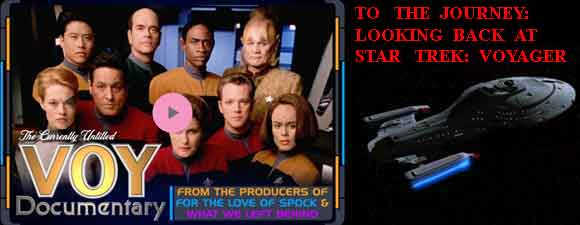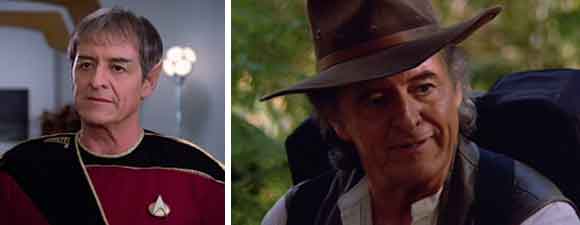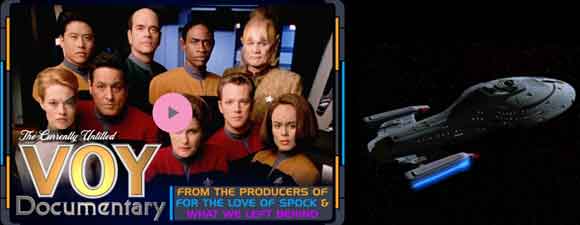Retro Review: Non Sequitur
7 min read
Non Sequitur
Harry Kim finds himself living in San Francisco, never having been assigned to Voyager.
Plot Summary: Though he dreams of Janeway advising him of an emergency transport, Kim wakes in San Francisco, where he lives with his girlfriend Libby. She reminds him that it’s the day on which he’s been looking forward to an important meeting. Slowly Kim discovers that he is now in a reality in which he and Libby are engaged, his friend Daniel was assigned to Voyager instead of himself, he and another friend, Lieutenant Lasca, are about to brief Starfleet Command on their experimental runabout. Local cafe owner Cosimo tells Kim how lucky he is to have such a good life. Though Kim’s command codes for Voyager still work, allowing him to access information about Voyager’s secret mission to the Badlands and its disappearance, no one else has any recollection of his ever being aboard or even assigned to the ship. The presentation at Starfleet Command goes disastrously and Kim arouses security’s attention, first because he has hacked into Voyager’s records, then because he goes to visit Tom Paris, who in this reality is also on Earth. Paris, who is slowly drinking himself to death at the non-holographic original Sandrine’s, explains that he was arrested for fighting with Quark on Deep Space Nine and imprisoned when Voyager left on its mission to find Chakotay’s ship. Paris believes Kim to be delusional, so Kim returns to San Francisco, where Lasca and Libby appear to have turned on him now that he faces an inquiry about his dealings with ex-Maquis criminal Paris. When Kim questions Cosimo, the cafe owner admits that he is really an alien from a space-time continuum that inadvertently sent Kim into this alternate timeline. Cosimo has tried to provide Kim with a pleasant life there, but Kim only wants to return to Voyager. To his surprise, Paris helps him evade arrest, piloting Kim on the experimental runabout to Cosimo’s time stream. Though Paris knows that he’ll die trying to restore Kim to his own timeline, Paris chooses to believe that he has another life in which he’s a hero. Though the runabout blows up, the attempt is successful, and on Voyager, Kim tells Paris that he owes him one.
Analysis: I gave “Non Sequitur” a scathing review when it first aired, and I have to admit that it’s as bad as I initially thought, though time and nostalgia have made certain aspects of it more appealing than they once were. When this installment was first shown, Deep Space Nine was still on the air, The Next Generation cast was still making movies, and we had no reason to believe we wouldn’t get to see 24th century San Francisco every couple of years, since both series visited regularly. Now it’s striking how lovely the city looks from Voyager‘s perspective, which focuses not on the briefly-seen Starfleet Command headquarters but on Kim’s Mission District neighborhood, where Old Town Festivals still use monthly dates and where buildings still have old-fashioned fire escapes. Much of the San Francisco footage is recycled from The Voyage Home and The Undiscovered Country, giving the episode even more of a sentimental feel. It’s a lovely mix of old and new; I don’t even mind the scenes in Kim’s apartment so much, since we get to see the city outside the enormous windows over the bed. Given how many Voyager episodes take place aboard the ship, with familiar gray equipment and black viewport starfields in the background, “Non Sequitur” seems to be full of color and light, a reminder of exactly why so many people on Voyager like Chakotay consider this planet home no matter how alienated they had become from it. In fact, director David Livingston does such a good job making Kim’s home appealing that it’s hard to believe how badly he wants to get back to Voyager, especially given that in “Eye of the Needle,” he was willing to return to the Alpha Quadrant twenty years early rather than risk being stuck in the Delta Quadrant for most of his life. He has options – he could tell Starfleet about the weird alien pretending to be a cafe owner and the time stream that’s a short runabout trip away, for starters – but he acts like a panicked kid separated from his family.
That we do believe Kim wants to return to Voyager rather than remain in this stiflingly boring alternate timeline is the result of a stiflingly boring screenplay. Harry and Libby have no chemistry, which I’ve often seen blamed on the actors, but I don’t think it’s fair to fault Jennifer Gatti (who’s quite good in The Next Generation‘s “Birthright” two-parter) for being unable to give depth to a character who’s written as the most painful girlfriend stereotype. She keeps blathering about how much she loves Harry, but why? We hear only his recollections of how they met. We have no idea what she does for professional or personal satisfaction, what hobbies they have in common, what their friends are like…anything, really, besides the fact that she likes sharing a bed and doesn’t like when Harry tries to talk seriously to her about how a cataclysmic upheaval has disrupted his life. (Apparently she’s not a scientist, or she’d know that this happens to space travelers all the time.) All her dialogue is babble about being in love and being upset that Harry’s concerns might mean he doesn’t love her as much. Given her lack of support for him, one would think he might contact his mother, whom Janeway told us in a previous episode has been so involved in his life that she wants to make sure Harry doesn’t fly off on Janeway’s ship without his clarinet. But we only see Harry with Libby in scenes of tedious romantic dialogue that drag on long enough to make me wish for a B plot, even if it’s Voyager being destroyed because the timeline changed or something predictable like that. We also get a few minutes of Harry at Starfleet with a guy who’s ostensibly his friend but is more interested in becoming a famous Starfleet engineer than taking care of Harry’s mental health, plus an admiral who’s fun for Trekkies to watch because he’s played by the same actor who played Justice Scalia in the Boston Legal finale and officiated at Denny Crane’s same-sex wedding (now that’s some fine fantasy writing – Scalia supporting gay marriage is less believable than wormhole aliens!).
Besides getting to see San Francisco, the other major pleasure of “Non Sequitur” is getting to see whom Tom Paris would become had he not met Harry Kim. Without Kim to rescue from Quark’s clutches on Deep Space Nine, Paris would have fought physically with Quark over the latter’s swindling and been arrested by Odo (oh, and it’s nostalgic to think about them, now that the two shows aren’t running simultaneously, so that I’m watching Voyager in my own alternate universe where Deep Space Nine is in the past). We see that Paris would have gone back to gambling, drinking, and getting into fights, presumably until he wound up back in prison or self-destructed, something he seems to consider such an inevitability that he’s willing to do it prematurely on a runabout to help someone he doesn’t remember as his friend. It’s enough that Kim remembers Paris as his friend. Sadly, we now know that in seven seasons on board Voyager, that’s pretty much all Harry will ever be – the optimistic ensign, the hard-working technical whiz kid, the devoted friend to Tom. This story focusing on his personal fate seems more negligible than ever because the writers never develop him into a character we can’t imagine the show without. How hard would it have been to give him a sense of humor like Paris’s? Or a naughty secret exposed by being back on Earth, like his official girlfriend Libby wasn’t really his true love? Or a real dark side that would have allowed him to consider joining the Maquis if it were the only way back into his own time stream and aboard Voyager? Couldn’t he at least have taken a swing at the alien who brought him there, who’s even more dull than the cloud, the swarm, and the rest of Voyager‘s usual anomalies of the week? The best the writers can come up with is a chase down the anachronistic fire escapes from which Starfleet doesn’t seem to know how to capture Kim or beam him away. Visually, it may be a nice change of pace, but everything else about this “Non Sequitur” is better forgotten.







I think you sum up the issue with Voyager that was predominant with Kim but an issue with many of them and that’s they can’t build characters. They’re chronic at it. Voyager often ducked that with great actors and good concepts, but when you don’t get either here (sorry Garrett) it shows. I didn’t mind this episode, it was a bit of froth and I like a change of pace which it was.
I don’t agree that he should be cheating, or have a dark secret etc. because all these things are just substitutes for characterisation. You can be ‘normal’ yet still interesting with good writing.
I like the idea they were going for but it just never comes together. This one is painful to watch. Really bad acting and horrible dialogue between Harry and Libby. Zero chemistry. They’re boring. The alien is boring. What a let down.
I’m watching Voyager for the first time — I lived in a TV-free household for a couple of decades — and I’m most of the way through the second season.
I like Janeway and Tuvok and The Doctor, and I find Kes and B’Elanna reasonably fun to watch. Chakotay seems like he has potential but isn’t there yet; Neelix has mostly been annoying comic relief, but “Jetrel” showed us that he could be a real character — and an interesting one — when the writers bothered to make him so. I have NO use for Tom Paris or Harry Kim and wish they’d be left behind or turned into those white dodecahedrons from “Return to Tomorrow” or something.
Whoever’s writing these episodes seems to make the younger men either bland or annoying, plus Garrett Wang doesn’t really seem up to the task of giving his character some oomph. Sulu very rarely got anything to do in TOS, but when he did, George Takei made it memorable. Wang has already gotten more to do than that but hasn’t actually DONE anything with it.
(I’m comparing Wang to Takei, not because they’re both Asian, but because there were two underused characters in TOS: Sulu and Uhura. When Uhura WAS used, sometimes Nichols was up to the job (as in “Mirror, Mirror”), and sometimes she wasn’t (as in “The Tholian Web”), whereas Takei was always excellent whenever they gave him anything to do. So the minor character in TOS whose actor made the most of every opportunity was Takei.)
I loved how you apparently escape from a fire (or guys trying to take you into custody) in the 24th Century by going down a metal fire escape on the outside of the building. You’d think the tech would’ve advanced by then. I also like how, when the security guys are going after Kim they beam into the apartment, but when he goes out the fire escape — they run after him! Why didn’t one stay in the apt. and the other beam down ahead of him? Not realizing the implication of the tech was another VOYAGER problem, and occasionally that of Trek in general.
I can tolerate occasional poor writing if the characters are at least enjoyable. I had a hard time liking or caring about the Voyager characters so that’s why it ended up my least favourite series. I do agree with Harry being underused… poor guy doesn’t even get promoted after everything they go through. If I remember correctly.
I remember this one just being mediocre, like they spun the character wheel and got ‘harry kim’ and then the story wheel landed on ‘time travel shenanigans’ and voila. i don’t think they should have used this idea so early in the series, maybe in season 5 or so when they really have been away from Earth for a long while and had some kind of longing. Also, and this one is petty but I hate the spacedock doors being the dyson sphere doors, unless the dyson sphere now IS spacedock. in which case….great?
The other thing that drives me insane is when Libby shuts the window and stands in front of it and the security guys are like, “Oh darn, she shut the window so I guess we’ll have to go the long way to get him!” Um, no, in real life they would have ordered her to move and then opened the window!
Harry should have been killed in season one a la Tasha Yar. It was obvious the character and the actor weren’t working out.